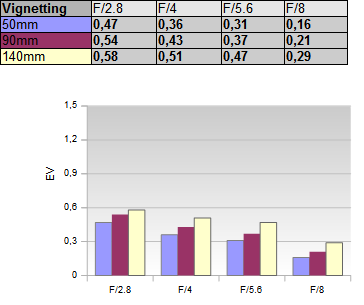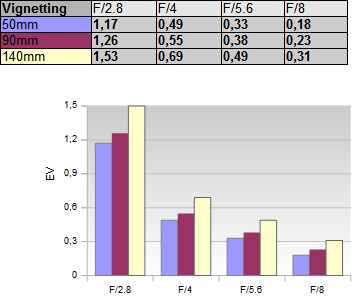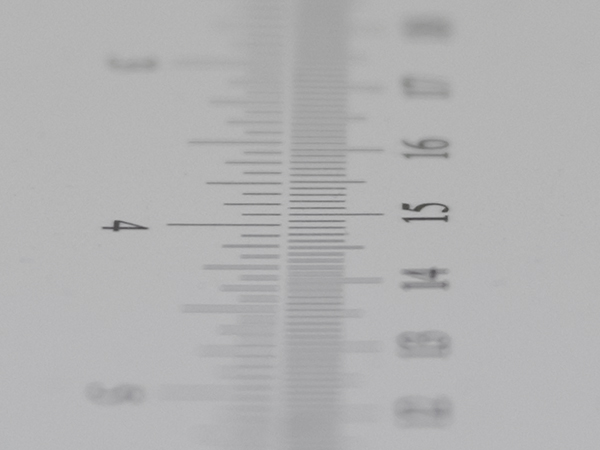|
Fujinon XF 50-140mm f/2.8 R LM OIS WR ( Fujifilm ) Review / Test - Analysis |
|
Lens Reviews -
Fujifilm X
|
|
Page 2 of 3

Distortion
Fujifilm relies on image auto-correction so users don't really need to worry about image distortions when keeping all default settings.
However, it's always interesting to look behind the scene. The original characteristic of the lens is, unsurprisingly, worse albeit not really bad. The distortions are pretty much negligible at 50mm but deteriorate towards medium pincushion distortions at longer focal lengths.
If you move your mouse cursor over the image you can switch to the corresponding auto-corrected results (there may be a short delay).
Vignetting
Image auto-correction is also active for compensating vignetting.
Thus the figures are very moderate even at f/2.8 with a maximum light falloff
around the 0.5EV (f-stop) mark.
 In RAW mode - thus With disabled vignetting- and distortion correction, the situation isn't all that shiny anymore.
The light falloff is clearly visible at max. aperture with a maximum of 1.5EV at 140mm. Stopping down to f/4 reduces the issue
to a manageable degree though.
In RAW mode - thus With disabled vignetting- and distortion correction, the situation isn't all that shiny anymore.
The light falloff is clearly visible at max. aperture with a maximum of 1.5EV at 140mm. Stopping down to f/4 reduces the issue
to a manageable degree though.
 Please note that vignetting compensation is also a lossy procedure because it increases the corner (sensor-)noise.
Please note that vignetting compensation is also a lossy procedure because it increases the corner (sensor-)noise.
MTF (resolution)
The Fujinon XF 50-140mm f/2.8 R LM OIS WR delivered impressive resolution results in the MTF lab.
The sweet spot is at 50mm with an outstanding quality across the image field straight from f/2.8.
The image center remains tack sharp at 90mm and 140mm but there border/corner quality isn't quite
as impressive. It's still good to very good at f/2.8 and improves slightly at medium aperture settings.
sharp. f/11 should be avoided due to diffraction effects but it remains a usable setting.
The field curvature is moderate. The centering quality of the tested sample was good albeit not perfect.
Please note that the MTF results are not directly comparable across the different systems!
Below is a simplified summary of the formal findings. The chart shows line widths
per picture height (LW/PH) which can be taken as a measure for sharpness.
If you want to know more about the MTF50 figures you may check out the corresponding
Imatest Explanations
Chromatic Aberrations (CAs)
Nothing to see here ... lateral CAs (color shadows at hard contrast transitions) are absolutely negligible!

Bokeh
An important aspect of a tele lens is the quality of the bokeh (rendering of the out-of-focus blur). The Fujinon delivers a solid performance here. The critical image background is very smooth for a zoom lens. The blur in the foreground is a little more busy.
 Out-of-focus highlights are nicely rendered with a quite smooth highlight disc and a moderate outlining effect. The disc shape deteriorates fairly "early" to "cat eyes" towards the image borders though - a vignetting effect. This effect is reduced when stopping down. The mentioned outlining of the highlight discs is getting more emphasized in this case though. A more edgy aperture shape starts to kick in at f/5.6
Out-of-focus highlights are nicely rendered with a quite smooth highlight disc and a moderate outlining effect. The disc shape deteriorates fairly "early" to "cat eyes" towards the image borders though - a vignetting effect. This effect is reduced when stopping down. The mentioned outlining of the highlight discs is getting more emphasized in this case though. A more edgy aperture shape starts to kick in at f/5.6

Bokeh Fringing
Bokeh fringing is an axial color fringing effect. It can show up as purple halos in front of the focus point and greenish halos in the background. However, this is usually affecting ultra-large aperture lenses. At f/2.8 it isn't really an issue.
|
Move the mouse cursor over the f-stop marks below to observe the respective LoCAs
|
| f/2.8 |
f/4 |
f/5.6 |
|

|
|